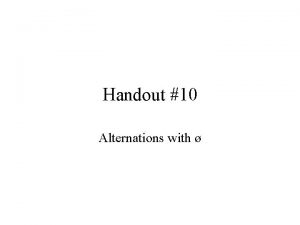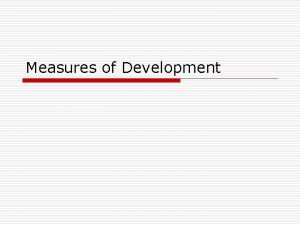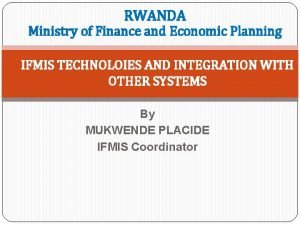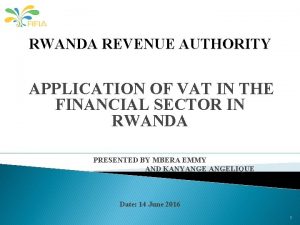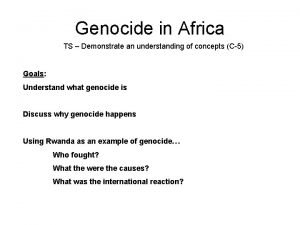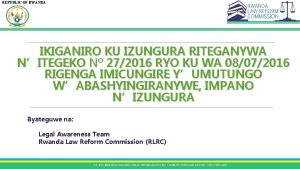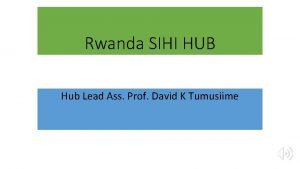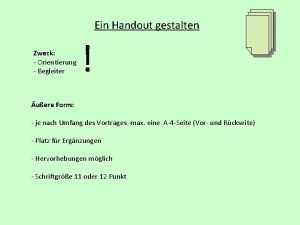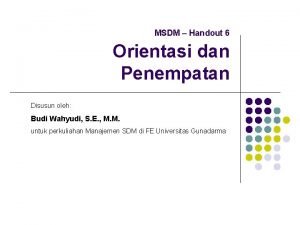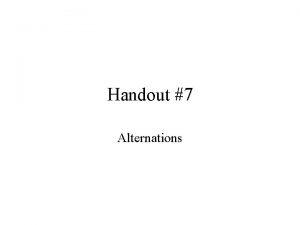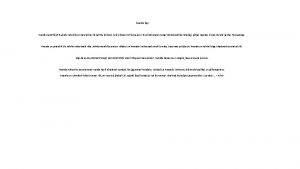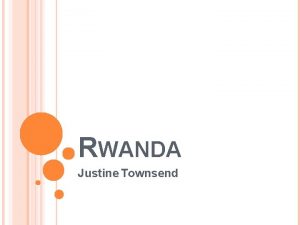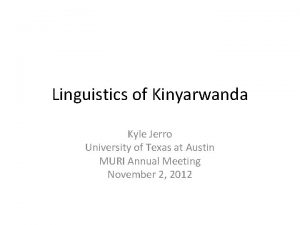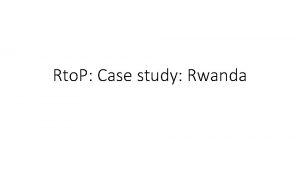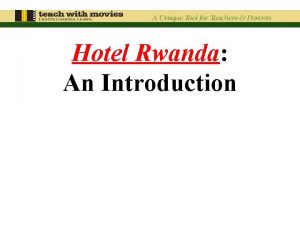Handout 10 Alternations with Kinyarwanda Rwanda jandika 8


















![Derivations /pa/ˇ - mi/ /pa/ˇ - al/ Epenthesis /pa/iˇmi/ _____ Surface representations [pa/iˇmi] [pa/ˇal] Derivations /pa/ˇ - mi/ /pa/ˇ - al/ Epenthesis /pa/iˇmi/ _____ Surface representations [pa/iˇmi] [pa/ˇal]](https://slidetodoc.com/presentation_image_h2/6684a5fb639e08a0b275216f60cc1984/image-19.jpg)



![i~u • Distribution of the alternating sounds: – [i] does not occur after u i~u • Distribution of the alternating sounds: – [i] does not occur after u](https://slidetodoc.com/presentation_image_h2/6684a5fb639e08a0b275216f60cc1984/image-23.jpg)





- Slides: 28

Handout #10 Alternations with ø

Kinyarwanda (Rwanda) • • • ja˘ndika 8 i. Bita. Bo 8 ja˘ndik i. Bita. Bo 8 book” • umu˘nhu 8 • a. Ragu. Ra 8 • umuho. Ro 8 “he/she writes” “a book” “he/she writes a “a person” “he/she buys” “pruning knife”

Kinyarwanda • umu˘nh a. Ragu. R umuho. Ro 8 “A person buys a pruning knife. ” • umu˘nhu ja˘ndika t. Sja˘ne 8 “The person writes a lot” • kuva˘na 8 “to come together” • iciga@li • “Kigali” • kuva˘n iciga@li • “to come together from Kigali”

Alternations • In these forms, the morpheme alternations are the following: – – ja˘ndika 8 ~ ja˘ndika umu˘nhu 8 ~ umu˘nhu a. Ragu. Ra 8 ~ a. Ragu. R kuva˘na 8 ~ kuva˘n

Alternations • Voiced vowels (e. g. a, u) alternate with voiceless vowels (e. g. a 8, u 8). • Distribution – Voiceless vowels occur only at the end of an utterance. – Voiced vowels occur only elsewhere. • Phonemes: /i, e, a, o, u/ • Rule (Final devoicing): – V --> [-voice] / ___ Utterance]

Alternations • Otherwise, the alternants differ in that one of the alternants has a final vowel, and the other doesn’t. • We say in this case that the vowel alternates with ø (the empty string, i. e. nothing): – a ~ a 8 ~ ø, u ~ u 8 ~ ø • The alternation indicates that there is a restriction on distribution.

Distribution • The empty string ø doesn’t have a distribution, so we can’t state the distribution of vowels relative to ø. • We just state the restriction on distribution in terms of which sequence doesn’t occur. • To determine what that restriction is, we look at the distribution of the alternants. • The alternant with the final vowel occurs before pause, or before a consonant.

Distribution • The alternants without a final vowel occur before a word beginning with a vowel. • Generalizing, what doesn’t occur is a sequence of two vowels: – *V V – The asterix indicates that the sequence is disallowed.

Analysis: Underlying representations • When two sounds are in neutralization distribution, the underlying representation of alternating morphemes has to have the sound with the restricted distribution. • Nonalternating morphemes have underlying representations with the unrestricted sound. • Only the restricted sound will be subject to change according to context.

Analysis: Underlying representations • The same logic extends to alternations with ø. • The restriction on distribution is on vowels - they can’t occur before vowels. • So alternating morphemes must have vowels in final position where they can come before vowels. • The underlying representations of the alternating morphemes must thus be: – /ja˘ndika, umu˘nhu, a. Ragu. Ra, kuva˘na/

Analysis: Rule • The rule must then take these underlying representations and turn them into the other ones (without final vowels) in the context where those occur. • Rule (Vowel Deletion): – V --> ø / ___ V • This rule changes a vowel to ø, i. e. it deletes it.

Derivations Underlying representations /ja˘ndika i. Bita. Bo/ Vowel deletion /ja˘ndik i. Bita. Bo/ Final devoicing Surface representations /ja˘ndik i. Bita. Bo 8/ [ja˘ndik i. Bita. Bo 8] /ja˘ndika/ _____ /ja˘ndika 8/ [ja˘ndika 8]

Yawelmani (California) (Kenstowicz and Kisseberth 1979: 77 -99)

Yawelmani (California) • The nonalternating morphemes here are the following: – – – – xat xil bok» -al -mi -en -hin “eat” “tangle” “find” “might” “having Verbed” “will” “present”

Yawelmani (California) • The alternating morphemes are the following: – pa/iˇ ~ pa/ˇ – /ilik ~ /ilk – logiw ~ logw “fight” “sing” “pulverize” • The alternating sounds are i ~ ø.

Distribution of alternants • All of the alternating stems have a final CC sequence in the alternants without [i]. • The nonalternating stems do not end in CC. • The alternant with the [i] vowel occurs before a suffix beginning with C, e. g. pa/iˇ -mi. • The alternants without the [i] vowel occurs before a suffix beginning with a V, e. g. pa/ˇ-al.

Distribution of alternating sounds • What we’re looking for is a generalization about a sequence that does not occur. • In this case, what doesn’t occur is a sequence of three C’s: – *C C C. • This is the distribution of the alternating sounds. • If the alternant without [i] occurred before a Cinitial suffix, CCC is what you’d expect to get: *pa/ˇ -mi.

Analysis • In this case what is ruled out is the sequence without the vowel. • So that is the sequence that should occur in the underlying representations of the alternating morphemes: – / pa/t, /ilk, logw / • The process eliminates the forbidden sequence by inserting a vowel (Epenthesis): – ø --> V [+high, -back] / C ___ C C
![Derivations paˇ mi paˇ al Epenthesis paiˇmi Surface representations paiˇmi paˇal Derivations /pa/ˇ - mi/ /pa/ˇ - al/ Epenthesis /pa/iˇmi/ _____ Surface representations [pa/iˇmi] [pa/ˇal]](https://slidetodoc.com/presentation_image_h2/6684a5fb639e08a0b275216f60cc1984/image-19.jpg)
Derivations /pa/ˇ - mi/ /pa/ˇ - al/ Epenthesis /pa/iˇmi/ _____ Surface representations [pa/iˇmi] [pa/ˇal] Underlying representations

Yawelmani: More data “might ___” “having ___ed” dubal dubmu Present Gloss dubhun hudal hudhun lead by the hand recognize /ugnal luk» lal /ugunmu /ugunhun drink luk» ulhun bury

New alternations • New alternations: – -mi ~ -mu – -hin ~ -hun – /ugn ~ /ugun – luk» l ~ luk» ul • Alternating sounds: –u~i –u~ø “might ___” “Present” “drink” “bury”

i~u • When one set of sounds alternates with another, as in i ~ u, the two sets must be either in complementary or neutralization distribution. • To discover the restriction on distribution, we look at the distribution of alternants. – -mu and -hun occur after stems whose last vowel is u. – -mi and -hin occur after all other stems.
![iu Distribution of the alternating sounds i does not occur after u i~u • Distribution of the alternating sounds: – [i] does not occur after u](https://slidetodoc.com/presentation_image_h2/6684a5fb639e08a0b275216f60cc1984/image-23.jpg)
i~u • Distribution of the alternating sounds: – [i] does not occur after u C 0, but does occur elsewhere. – [u] occurs after u C 0, as well as elsewhere. • Underlying representations of the alternating morphemes: – / -mi, -hin/ • Rule (Vowel harmony) – V --> [+back, -cor, +lab] / V C 0 _____ [+high] [+lab, +high]

u~ø • The distribution of the u ~ ø alternants is exactly like that of the i ~ o alternants: – The alternants with the u occur before suffixes beginning with C. – The alternants without u end in CC and occur before suffixes beginning with V. – But the u ~ ø alternation occurs in the forms with the suffix alternants -mu or -hun. – The i ~ ø alternation occurs with the suffix alternants mi or -hin.

Analysis • The simplest analysis is that the i that is introduced by epenthesis is subject to Vowel harmony, just like any other high vowel. • To make this happen, we just have to insure that Epenthesis applies before Vowel harmony. • Underlying representations of the alternating morphemes: – //ugn, luk» l/

Derivations Underlying representation //ugn - hin/ /pa/ˇ - mi/ Epenthesis //ugin - hin/ /pa/iˇ - mi/ //ugun - hun/ ______ [/ugunhun] [pa/iˇmi] Vowel harmony Surface representation

Rule ordering • This analysis only works if Vowel Epenthesis applies before Vowel Harmony. • Vowel Epenthesis creates opportunities for Vowel Harmony to apply. • If Rule A creates opportunities for Rule B to apply (i. e. Rule B couldn’t apply to the underlying representation but can apply to the output of Rule A), then Rule A is said to feed Rule B. • Rule A must be applied before rule B.

Reference • Kenstowicz, Michael and Charles Kisseberth (1979). Generative Phonology: Description and Theory. Academic Press, San Diego.
 Jandika
Jandika Proverbs in kinyarwanda
Proverbs in kinyarwanda Dot rwanda
Dot rwanda Human development index rwanda
Human development index rwanda Rwanda genocide map
Rwanda genocide map Ncsa rwanda
Ncsa rwanda Smart ifmis
Smart ifmis Rwanda textile industry
Rwanda textile industry Hotel rwanda recensione
Hotel rwanda recensione Difference between centrifugal and centripetal force
Difference between centrifugal and centripetal force Hoteles darfur
Hoteles darfur Rwanda was colonized by which country
Rwanda was colonized by which country Rwanda health management information system
Rwanda health management information system Vat calculation in rwanda
Vat calculation in rwanda Edprs rwanda
Edprs rwanda Aceesd rwanda
Aceesd rwanda Paul kagame rwanda
Paul kagame rwanda Izungura 2016
Izungura 2016 Rwanda konflikt
Rwanda konflikt Hotle rwanda
Hotle rwanda Rwanda ass
Rwanda ass Johari window handout
Johari window handout Handout 5-2 graphic organizer the brain answers
Handout 5-2 graphic organizer the brain answers Wise mind handout
Wise mind handout Slidetodoc.com
Slidetodoc.com Karakteristik handout
Karakteristik handout Pharyngorrhea
Pharyngorrhea Apa itu orientasi
Apa itu orientasi Definition of handouts
Definition of handouts
